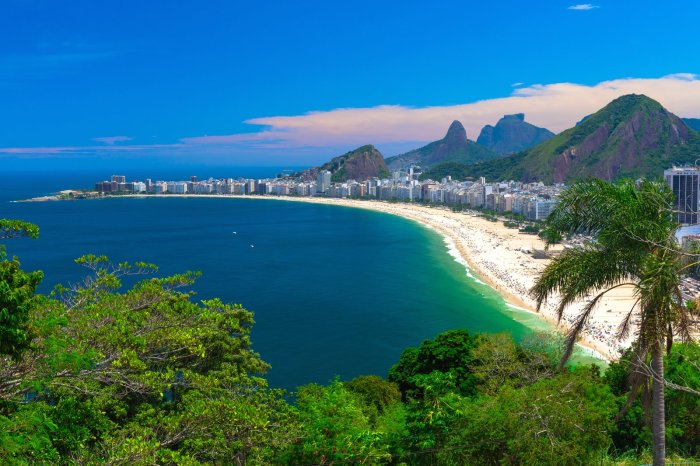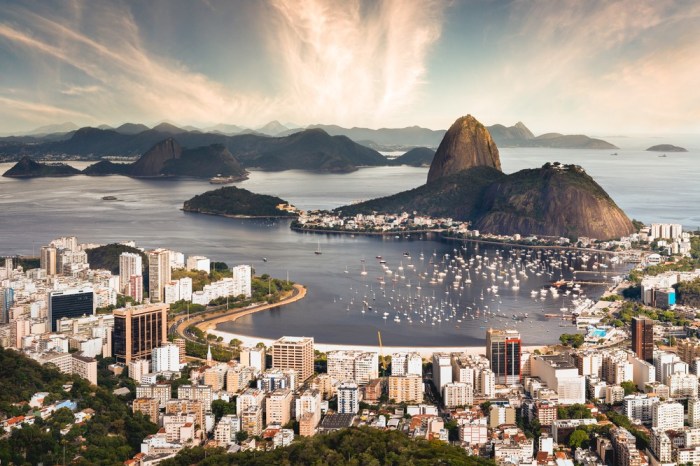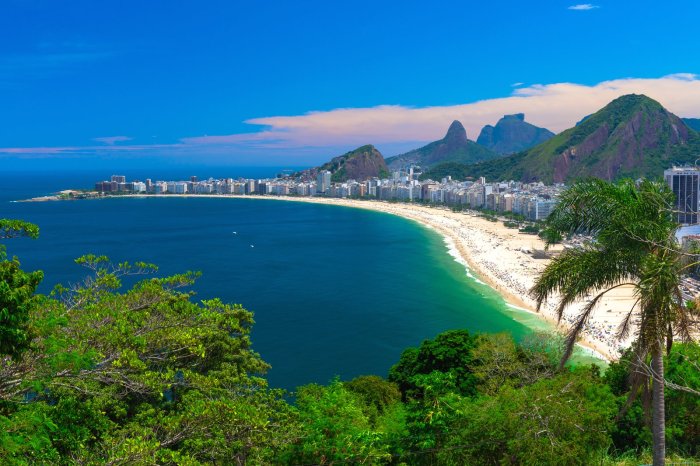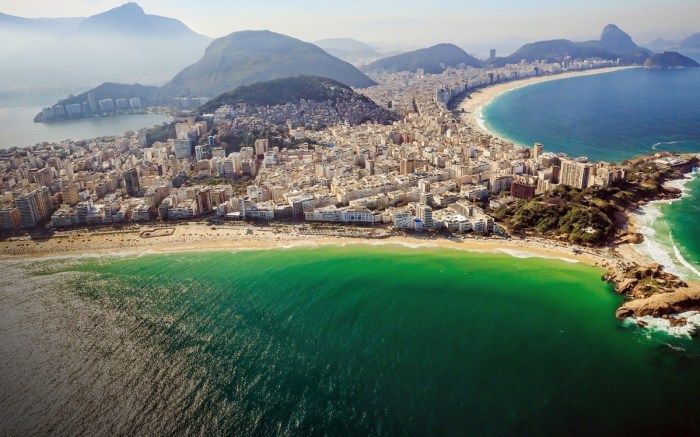Top things to do in Rio de Janeiro: Discover the vibrant tapestry of Brazil’s iconic city, from the awe-inspiring Christ the Redeemer statue to the sun-drenched beaches of Copacabana and Ipanema. Explore the local culture, savor delicious cuisine, and uncover hidden gems beyond the tourist hotspots. This guide unveils the must-sees and provides practical tips for planning your unforgettable Rio adventure.
This comprehensive guide will be your perfect companion for navigating the diverse offerings of Rio de Janeiro. We’ll delve into the city’s history, culture, and iconic landmarks, offering insights into its neighborhoods and unique experiences. From iconic landmarks to local traditions, and from exciting activities to practical travel information, we cover it all.
Introduction to Rio de Janeiro
Rio de Janeiro, a vibrant city nestled on the Atlantic coast of Brazil, pulsates with a unique blend of history, culture, and natural beauty. From its colonial past to its modern-day status as a global tourist destination, Rio has captivated hearts and minds for centuries. Its iconic landmarks, bustling neighborhoods, and lively atmosphere create an unforgettable experience for visitors.This introduction to Rio will provide a glimpse into the city’s rich tapestry, guiding you through its key attractions, diverse neighborhoods, and the cultural significance that makes it so special.
Discover the charm of this unforgettable South American gem.
Historical Overview
Rio de Janeiro’s history is deeply intertwined with its geographic location. Initially a strategic port for Portuguese explorers, it quickly became the capital of the colony and later, of the independent nation of Brazil. The city’s evolution is reflected in its architecture, from colonial-era buildings to modern skyscrapers, showcasing a fascinating blend of influences. The transfer of the capital to Brasilia in 1960 marked a significant turning point in Rio’s history, but its cultural heart remained vibrant.
This rich history continues to shape the city’s identity and is evident in its art, music, and traditions.
Key Attractions and Landmarks
Rio is renowned for its iconic landmarks, each representing a chapter in its history or a facet of its culture. Sugarloaf Mountain, with its panoramic views, stands as a symbol of the city’s natural beauty. Christ the Redeemer, perched atop Corcovado Mountain, is a globally recognized symbol of both faith and Brazilian pride. Copacabana Beach, with its golden sands and lively atmosphere, is a beloved spot for both locals and tourists.
These are just a few of the many iconic landmarks that await your discovery.
Neighborhoods and Their Characteristics
Rio’s neighborhoods are as diverse as its history. Each neighborhood possesses a unique character, from the glamorous beaches of Ipanema and Leblon to the bohemian and artistic vibe of Lapa. The historical center, with its colonial architecture, is a testament to Rio’s rich past. These distinct neighborhoods offer a glimpse into the city’s multifaceted soul.
- Ipanema: Known for its upscale atmosphere, beautiful beaches, and trendy restaurants, Ipanema is a favorite among tourists and locals alike. Its iconic beachfront promenade and vibrant nightlife create a distinctive ambiance. This neighborhood exemplifies the luxury and elegance of Rio de Janeiro.
- Copacabana: Famous for its long stretch of golden sand, Copacabana Beach is a popular destination for sunbathing, swimming, and people-watching. Its bustling atmosphere and vibrant nightlife attract a large number of visitors. The neighborhood reflects the city’s vibrant energy and welcoming nature.
- Santa Teresa: Steeped in history and culture, Santa Teresa boasts a charming collection of colonial-era buildings, cobblestone streets, and art galleries. Its bohemian vibe and unique character offer a captivating escape from the city’s bustle.
Iconic Landmarks and Must-See Attractions: Top Things To Do In Rio De Janeiro
Rio de Janeiro, a city sculpted by nature’s hand, boasts an array of iconic landmarks that captivate visitors from around the globe. From the majestic Christ the Redeemer statue overlooking the sprawling metropolis to the dramatic beauty of Sugarloaf Mountain, each landmark tells a story of the city’s rich history and vibrant culture. Exploring these treasures provides a profound understanding of Rio’s unique character.
Christ the Redeemer Statue
The iconic Christ the Redeemer statue, perched atop Corcovado Mountain, stands as a symbol of Brazil and Rio de Janeiro. Its architectural design, a blend of Art Deco and Art Nouveau influences, features a sweeping posture, arms outstretched in a gesture of welcome and peace. Built in the early 20th century, the statue’s construction was a monumental feat of engineering, requiring intricate planning and execution.
The statue’s position, overlooking the city’s panorama, offers breathtaking views of Rio’s urban sprawl and the surrounding lush landscape. The statue’s historical significance lies not only in its artistic merit but also in its role as a powerful symbol of faith and national pride.
Sugarloaf Mountain
Sugarloaf Mountain, a dramatic granite peak rising from Guanabara Bay, presents a captivating sight. Its unique shape, resembling a sugarloaf, is a prominent feature of the Rio skyline. The mountain is accessible by cable car, offering a scenic journey through lush vegetation to the summit. From the peak, panoramic vistas of the city, Guanabara Bay, and surrounding islands unfold, providing a spectacular perspective of Rio’s urban landscape and natural beauty.
The cable car ride itself is an experience, with views of the city unfolding beneath.
Copacabana and Ipanema Beaches
Copacabana and Ipanema beaches, two of Rio’s most famous destinations, epitomize the city’s vibrant lifestyle. Copacabana Beach, known for its wide expanse of sand and bustling atmosphere, is a popular spot for sunbathing, swimming, and enjoying the lively beachside promenade. Ipanema, in contrast, exudes a more relaxed and sophisticated vibe. The narrower beach, known for its bohemian charm and upscale atmosphere, is a favourite for leisurely strolls, surfing, and soaking up the sun.
Beach Comparison
Copacabana Beach, with its broad expanse, is perfect for families and those seeking a lively, bustling atmosphere. The vibrant energy and diverse activities make it a popular destination. Ipanema, on the other hand, offers a more intimate and sophisticated experience, with a focus on upscale shops, restaurants, and a relaxed, stylish ambiance. Both beaches, however, provide an authentic taste of Rio’s beach culture.
Selarón Steps
The Selarón Steps, a vibrant mosaic masterpiece, are a unique and captivating attraction. Created by Chilean artist Jorge Selarón, the steps are adorned with colourful tiles from around the world. The artistic value of the steps lies in their eclectic mix of colours and patterns, reflecting the artist’s vision and dedication to transforming a mundane space into a work of art.
The steps are a focal point for tourists and locals alike, offering a delightful spectacle of artistic expression and vibrant colour.
Top 5 Must-See Attractions
- Christ the Redeemer: A breathtaking statue overlooking the city, offering panoramic views.
- Sugarloaf Mountain: A dramatic granite peak with stunning views from the summit accessible by cable car.
- Copacabana Beach: A bustling beach with a vibrant atmosphere, ideal for sunbathing and enjoying the city’s energy.
- Ipanema Beach: A more relaxed and sophisticated beach, known for its bohemian charm and upscale atmosphere.
- Selarón Steps: A colourful mosaic masterpiece, transforming a set of steps into a work of art.
Top 5 Must-See Attractions (Detailed)
| Attraction Name | Brief Description | Estimated Time to Visit |
|---|---|---|
| Christ the Redeemer | Iconic statue atop Corcovado Mountain, offering panoramic views. | 2-3 hours (including travel time) |
| Sugarloaf Mountain | Dramatic granite peak with cable car access, featuring stunning views. | 2-3 hours (including travel time and summit exploration) |
| Copacabana Beach | Wide expanse of sand, bustling atmosphere, perfect for relaxation and people-watching. | 2-4 hours (depending on activities) |
| Ipanema Beach | Sophisticated beach with a relaxed vibe, ideal for strolling and enjoying the upscale atmosphere. | 2-4 hours (depending on activities) |
| Selarón Steps | Vibrant mosaic masterpiece transforming a set of steps into a work of art. | 1-2 hours |
Experiencing Local Culture and Traditions
Rio de Janeiro pulsates with a vibrant tapestry of local culture and traditions, interwoven with its iconic landmarks. Beyond the famous beaches and Christ the Redeemer statue, lies a rich heritage waiting to be explored. Immersing yourself in these traditions offers a deeper understanding and appreciation of the city’s soul. From the infectious rhythms of Samba to the tantalizing flavors of local cuisine, Rio’s cultural scene is a feast for the senses.
Popular Local Events and Festivals
Rio de Janeiro hosts a calendar brimming with vibrant festivals and events throughout the year. Carnival, a world-renowned spectacle, is perhaps the most famous, with elaborate parades, costumes, and music filling the streets. Other significant events include the Rio de Janeiro International Film Festival, attracting filmmakers and movie enthusiasts from around the globe, and numerous religious celebrations marking the city’s diverse cultural heritage.
The Significance of Samba
Samba, a cornerstone of Brazilian culture, is deeply ingrained in Rio’s identity. The infectious rhythms and energetic movements of Samba dance embody the city’s passion and spirit. Samba schools, dedicated groups of dancers and musicians, compete in spectacular parades during Carnival, showcasing their intricate choreography and elaborate costumes. These performances are not just displays of artistry; they are deeply rooted in Brazilian history and social life, with roots in African and European musical traditions.
Rio de Janeiro boasts iconic landmarks like Christ the Redeemer and Sugarloaf Mountain, but if you’re looking for a different kind of adventure, you might consider exploring the stunning beaches and vibrant culture of Antigua and Barbuda. For a detailed guide to Antigua and Barbuda, check out this excellent resource: guide to antigua barbuda. Ultimately, though, Rio’s charm and diverse offerings still make it a must-see destination.
Local Cuisine and Restaurants
Rio’s culinary scene is a vibrant reflection of its diverse population. The city boasts a plethora of restaurants offering everything from traditional Brazilian dishes to international cuisines. Feijoada, a hearty stew made with black beans and various cuts of pork, is a quintessential Brazilian dish. Other popular choices include moqueca, a seafood stew, and acarajé, a savory fritter made from black-eyed peas.
Finding authentic restaurants is easy, and locals often recommend hidden gems, often located in neighborhoods like Santa Teresa or Lapa, offering a taste of local life.
Visiting Local Markets and Street Vendors
Immerse yourself in the local atmosphere by visiting the bustling markets and street vendors. These vibrant marketplaces offer a chance to experience firsthand the daily life of Rio’s residents, interacting with vendors, and sampling local delicacies. Feira Hippie, for instance, is a popular market offering everything from handmade crafts to fresh produce, creating a vibrant and colorful experience.
Rio’s got incredible sights, from Christ the Redeemer to Sugarloaf Mountain. Planning a trip on a budget? Finding affordable activities and accommodations in a place like Rio de Janeiro can be surprisingly easy, similar to how you can save money in Auckland, New Zealand. Checking out resources like auckland on a budget can offer some great tips for keeping costs down while still enjoying the best of the city.
Once you’ve got your budget sorted, you can fully immerse yourself in the vibrant culture and stunning scenery of Rio de Janeiro.
Street vendors are also an important part of the local scene, offering delicious snacks and drinks at affordable prices.
Local Transportation Options, Top things to do in rio de janeiro
Navigating Rio de Janeiro can be a unique experience. The city offers a diverse range of transportation options, catering to various budgets and preferences. From the iconic yellow taxis to the efficient metro system, and the colorful vans, understanding the nuances of each option can make a trip more enjoyable. The efficiency of the metro system, coupled with the affordability of vans, offers a balance of speed and cost-effectiveness.
| Mode | Cost | Time | Convenience |
|---|---|---|---|
| Metro | Moderate | Fast | Efficient, especially for long distances |
| Taxi | Variable | Variable | Convenient, but can be expensive during peak hours |
| Van | Affordable | Variable | Often faster than metro for shorter distances, but less reliable |
Activities and Experiences

Rio de Janeiro offers a vibrant tapestry of activities, from exploring iconic landmarks to immersing oneself in the local culture. Beyond the postcard-perfect views and famous beaches, the city pulses with experiences waiting to be discovered. This section dives into the diverse tours, nightlife, and outdoor adventures that make Rio a truly unforgettable destination.Experiencing Rio goes beyond simply visiting famous landmarks.
It’s about engaging with the city’s dynamic spirit, from its bustling markets to its vibrant nightlife. This section provides insights into the diverse activities available, highlighting unique experiences and practical considerations for your trip.
Types of Tours
Rio boasts a wide array of tours catering to various interests. Guided tours provide valuable context and insights into the city’s history and culture. These tours often cover specific themes, such as historical sites, art galleries, or local neighborhoods. Alternatively, private tours offer a personalized experience, tailoring the itinerary to your specific preferences and interests. Many tour operators offer customized packages combining different elements, creating an unforgettable journey through the city.
Rio de Janeiro boasts iconic landmarks like Christ the Redeemer and Sugarloaf Mountain, but for a truly rejuvenating experience, consider a stay at the 1 hotel hanalei bay kauai hawaii within wellness program. Their focus on wellness, combined with the stunning Kauai scenery, makes it a perfect escape. Exploring the vibrant culture and beaches of Rio is still a must-do, though!
Favela Tours
Visiting a favela offers a unique and often eye-opening perspective into the lives of the local communities. These tours are designed to provide a safe and respectful experience, offering insights into the culture, challenges, and resilience of the residents. They are more than just sightseeing; they are opportunities for cultural exchange and understanding. However, it’s crucial to choose reputable tour operators that prioritize the safety and well-being of both the visitors and the community.
Tours often include discussions with local residents, providing valuable insights into their experiences.
Nightlife Options
Rio’s nightlife is renowned for its vibrant energy and diverse options. From upscale bars and nightclubs to cozy pubs and live music venues, there’s a scene to match every taste. The Copacabana and Ipanema beaches are popular choices for evening strolls and bar hopping, offering a lively atmosphere. For a more intimate experience, explore the smaller bars and clubs in Lapa, known for its lively music and dance scene.
These areas often feature different styles of music and dancing, from traditional samba to international beats.
Comparison of Nightlife Experiences
Comparing nightlife experiences in Rio highlights the variety available. Copacabana and Ipanema offer a more tourist-focused scene, with a mix of international and local music. Lapa, in contrast, often features more local entertainment, including live music and traditional samba performances. The cost and atmosphere also vary; upscale venues generally have higher entry fees and attract a more affluent clientele, while smaller venues provide a more relaxed and affordable experience.
Each area offers a unique nightlife experience, allowing travelers to choose based on their preferences and budget.
Outdoor Activities
Rio’s natural beauty offers numerous outdoor adventures. From hiking in the Tijuca National Park to sunbathing on Copacabana Beach, there’s something for everyone. Exploring the trails of the park offers stunning views and opportunities to connect with nature. The city’s beaches are iconic, providing relaxation, swimming, and watersports. Boating tours offer unique perspectives on the city’s coastline.
Outdoor Activities Table
| Activity Type | Location | Cost |
|---|---|---|
| Hiking in Tijuca National Park | Tijuca National Park | Entrance fees vary, transportation costs may apply. |
| Sunbathing and swimming on Copacabana Beach | Copacabana Beach | Free (excluding beach umbrellas and rentals) |
| Boating Tour | Guanabara Bay | Varying depending on the tour operator and duration. |
| Visiting Sugarloaf Mountain | Sugarloaf Mountain | Entrance fees apply, transportation costs may apply. |
| Visiting Christ the Redeemer | Corcovado Mountain | Entrance fees apply, transportation costs may apply. |
Accommodation and Food Recommendations
Rio de Janeiro offers a diverse range of accommodation options to suit every budget and preference. From luxurious beachfront resorts to charming boutique hotels in historic neighborhoods, travelers can find the perfect place to rest and recharge after exploring the city’s iconic landmarks and vibrant culture. Food in Rio is equally diverse, reflecting the city’s multicultural heritage and the abundance of fresh, local ingredients.
This section provides recommendations for accommodation and dining experiences, categorized by price range and neighborhood.
Accommodation Options
Rio’s accommodation options cater to various budgets and preferences. The city offers a range of hotels, from budget-friendly hostels to luxurious resorts, catering to solo travelers, couples, and families. Choosing the right neighborhood for your accommodation can significantly enhance your experience.
- Ipanema and Leblon: Known for their upscale hotels, beachfront apartments, and boutique accommodations. These neighborhoods offer a luxurious stay with stunning views and high-end amenities. Expect to find a range of five-star hotels and exclusive condominiums. The proximity to the beach and vibrant nightlife adds to the allure of these neighborhoods.
- Copacabana: A classic tourist destination, Copacabana offers a wide array of hotels, from mid-range to luxury. The neighborhood’s iconic beach and bustling atmosphere create a lively environment for visitors. You’ll find both budget-friendly and luxurious options, catering to diverse needs and budgets.
- Santa Teresa: This charming neighborhood is known for its historic buildings, cobblestone streets, and unique boutique hotels. The neighborhood provides a more local experience, offering a blend of history and modern comfort. Expect to find a more intimate and unique stay.
- Centro: The city center offers a range of hotels, from budget-friendly hostels to mid-range options, often closer to historical sites and transportation hubs. This is an ideal choice for those who want to be in the heart of the city’s action, providing easy access to attractions and nightlife.
Cuisine in Rio de Janeiro
Rio’s cuisine is a vibrant tapestry woven from diverse cultural influences. The city’s proximity to the ocean means fresh seafood is a cornerstone of its culinary scene, often prepared with simple, yet flavorful, techniques. The city also offers a wide array of Brazilian dishes, showcasing the country’s unique flavors and culinary traditions. Beyond these staples, international influences have added a modern twist to the local fare.
Recommended Restaurants
Rio de Janeiro boasts a wide array of restaurants, reflecting the city’s multicultural heritage and diverse tastes. From traditional Brazilian steakhouses to international cuisines, the city offers a culinary experience for everyone. The following list provides recommendations categorized by cuisine type and price range.
| Restaurant Name | Cuisine Type | Price Range |
|---|---|---|
| A Casa do Porco | Brazilian (pork) | Mid-range |
| D.O.M. | Modern Brazilian | High-end |
| La Mer | Seafood | High-end |
| Bar do Mineiro | Brazilian (traditional) | Budget-friendly |
| Pizza da Lunga | Italian | Mid-range |
| Restaurante Brasileiro | Brazilian (diverse) | Mid-range |
Practical Information and Tips
Rio de Janeiro, a vibrant city brimming with culture and natural beauty, offers an unforgettable experience for visitors. However, meticulous planning is key to making the most of your trip. This section provides essential practical information to ensure a smooth and enjoyable journey.Planning your trip involves understanding the best time to visit, the local currency, necessary travel documents, safety precautions, and visa requirements.
This comprehensive guide will help you navigate these aspects effectively.
Best Time to Visit
Rio’s weather significantly impacts your experience. The best time to visit is during the shoulder seasons, typically spring (September to November) and autumn (March to May). These months offer pleasant temperatures, sunny days, and fewer crowds compared to the peak summer months (December to February). Summer brings scorching heat and higher humidity, while winter (June to August) can have occasional rain showers, although the days are often sunny.
Local Currency and Exchange Rates
The official currency of Brazil is the Brazilian Real (BRL). Exchange rates fluctuate, so it’s wise to check current rates before your trip. You can exchange currency at banks, exchange bureaus, or use your credit/debit card for transactions. It’s generally recommended to have some BRL on hand for smaller purchases and transportation, as not all vendors accept credit cards.
Necessary Travel Documents
Valid passports are essential for international visitors. Ensure your passport’s validity extends beyond your intended stay in Brazil. Check the specific requirements for your nationality regarding visa regulations and travel documents.
Essential Safety Tips for Tourists
Rio, like any major city, has its own set of safety considerations. Be mindful of your surroundings, especially in crowded areas. Avoid displaying expensive jewelry or electronics, and be cautious when using ATMs. Stick to well-lit and populated areas at night. Inform someone of your itinerary, and keep your valuables secure.
Visa Requirements for International Visitors
Visa requirements vary based on your nationality. Check the Brazilian consulate or embassy website for the most up-to-date information on visa regulations. Many nationalities may be eligible for a tourist visa for short stays. It is imperative to confirm the specific requirements before travel to avoid complications at the airport.
Travel Document Requirements
| Travel Document | Required Validity (minimum) | Applicable Fees |
|---|---|---|
| Passport | At least six months beyond your intended stay | Visa fees may apply, depending on nationality. Consult the Brazilian embassy/consulate for details. |
| Visa (if required) | Valid for the duration of your stay | Fees vary depending on nationality and visa type. Refer to the Brazilian embassy/consulate website. |
Exploring Beyond the Tourist Hubs
Rio de Janeiro’s allure extends far beyond the iconic Christ the Redeemer and Sugarloaf Mountain. Beyond the bustling tourist zones lie hidden gems, offering authentic local experiences and breathtaking natural beauty. Venturing outside the city center reveals a different side of Rio, one steeped in local traditions and captivating landscapes. Discovering these less-trodden paths enriches your understanding of the vibrant culture and offers a more immersive travel experience.Beyond the postcard-perfect views, Rio has a rich tapestry of local experiences waiting to be discovered.
These hidden gems provide a deeper connection with the city’s soul and a more authentic understanding of its inhabitants.
Less-Known Attractions
Rio boasts a surprising number of less-known attractions, offering a unique perspective on the city’s diverse offerings. These hidden gems often showcase the city’s artistic, historical, and natural treasures in a less commercialized setting. These locations are often more intimate and provide a more personal experience for visitors.
Day Trips Outside the City Center
Taking a day trip outside the city center opens up a world of natural wonders and cultural experiences. These excursions offer a chance to escape the crowds and discover the beauty of the surrounding areas. These destinations offer a chance to experience Rio’s stunning natural landscapes, explore its rich history, and encounter the local culture.
Areas with Unique Local Experiences
Certain neighborhoods outside the central tourist zone offer unique and immersive experiences for travelers. These areas often provide insight into the daily lives of Rio’s residents and offer a more genuine perspective of the city’s culture. These experiences offer visitors the chance to delve deeper into the heart of Rio, beyond the typical tourist hotspots.
Table of Day Trip Destinations
| Destination | Description | Distance from City Center (approximate) |
|---|---|---|
| Pedra Bonita | A picturesque mountaintop offering panoramic views of the Guanabara Bay. It’s perfect for hiking, enjoying nature, and capturing stunning photos. | Approximately 45-60 minutes by car |
| Ipanema Beach (Beyond the Main Strip) | Explore the quieter stretches of Ipanema Beach, away from the crowds and high-end hotels. Discover local shops, restaurants, and the genuine Ipanema atmosphere. | Within the city, but often involves navigating the streets. |
| Tijuca National Park | Explore the lush rainforest, hike through trails, and discover waterfalls. This is a great way to escape the city bustle and reconnect with nature. | Approximately 30-45 minutes by car |
| Santa Teresa | This charming neighborhood boasts historic architecture, cobblestone streets, and a bohemian vibe. Discover art galleries, cafes, and unique shops. | Approximately 20-30 minutes by car |
Last Point
In conclusion, Rio de Janeiro offers a rich blend of history, culture, and natural beauty. Whether you’re seeking iconic landmarks, vibrant nightlife, or cultural immersion, this guide provides a roadmap to crafting your perfect Rio adventure. From the bustling streets to the tranquil beaches, Rio has something to offer every traveler. Prepare to be captivated by its energy and charm!







